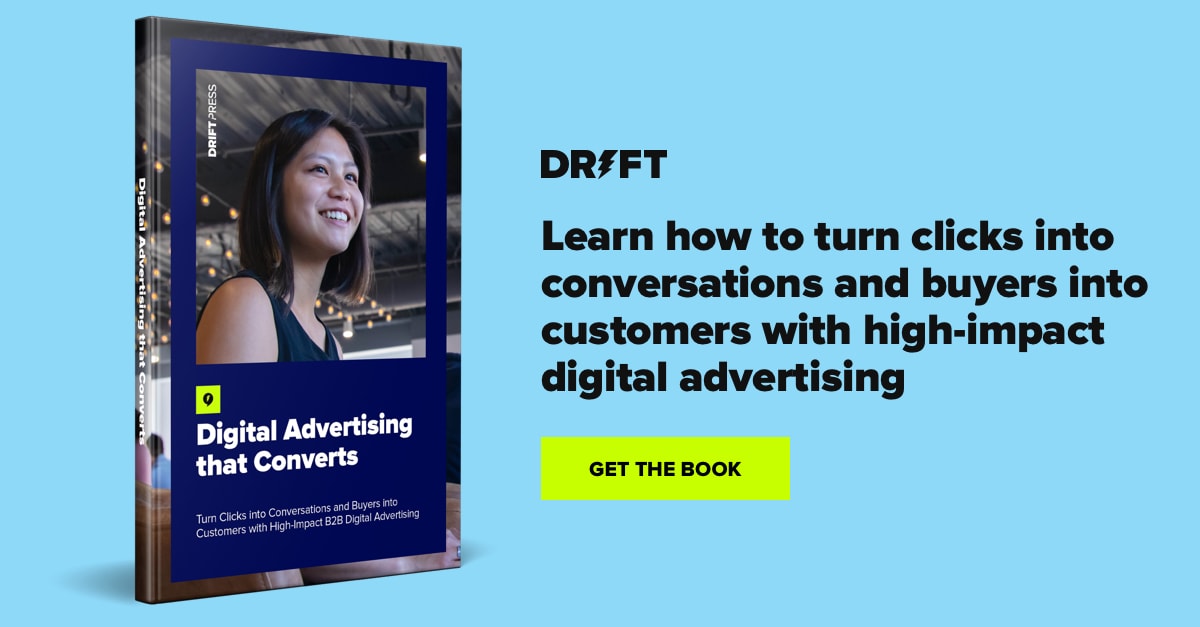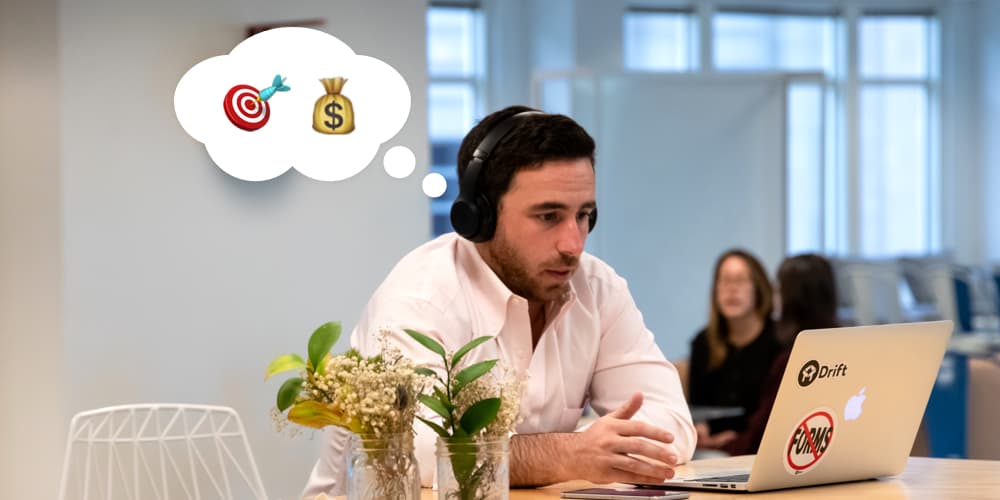Trying to find new and innovative ways to up your company’s content marketing game? Want to get more traction and conversions from the content you already have? Want to get sales closer to your buyers? Good news – you’re in the right place.
As a senior digital marketing manager here at Drift, I own programs across organic search, email, paid ads, and more. That’s a pretty wide variety of channels, but they all have one thing in common – high-quality content. Content is the not-so-secret weapon for any digital marketer. That’s why I work super closely with Drift’s content team. We make sure we’re not just creating great content, but that we’re aligned on the topics our buyers and customers want to read about – and that we’re promoting it in a way that’s going to generate results.
I’m sharing how to break through the noise and stand out from the competition with a content strategy that converts.
I spoke about this strategy on a webinar with Marketing Profs. If you want to watch the full presentation, click here. Otherwise, keep reading for all the insights 💡
Content’s Impact on the Bottom Line
63% of the opportunities created at Drift in the last 12 months have a content touchpoint somewhere in their journey 🤯
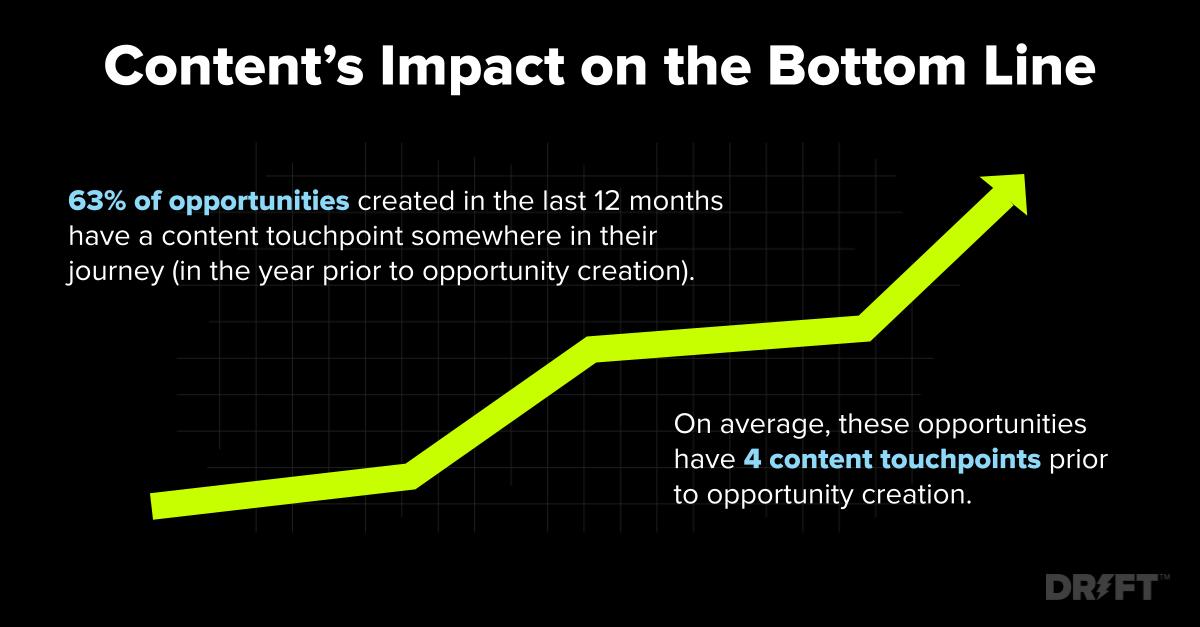
This shows you how valuable content is, not only in terms of brand awareness, but actually filling up your funnel.
And on average, these opportunities have four content touchpoints.
What does this tell you? You need to push out a broad range of content you need for a successful program, whether that’s on your blog or through gated content, ebooks, or podcasts.
How do we make that happen? Conversational Marketing.
How Conversational Marketing Takes Your Content Strategy to the Next Level
It’s time to invest in content.
It works. While we often think about content marketing through the lens of the funnel, it really comes down to a two-pronged approach:
- Using content to drive awareness of brand and product
- Amplifying that content to drive demand
Let’s dive into each side of a content strategy based in Conversational Marketing.
3 Ways to Use Content to Drive Awareness of Brand and Product
First, you need to fill up the top of your funnel by driving awareness of your brand and your product.
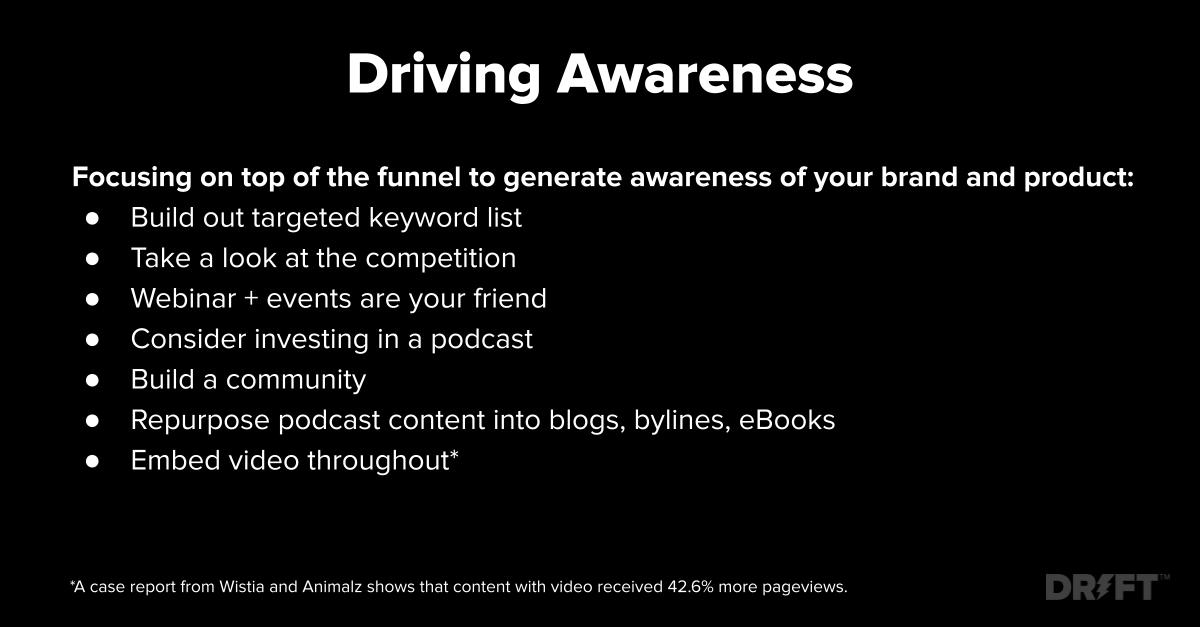
Content generates a lot of buzz around your brand. And when you’ve built up trust with high-quality content, it’s that much more difficult to be displaced by a competitor.
Here are three ways to develop a content strategy that drives awareness of your brand and product to a larger audience:
1. Organic Search
The number one question I always get asked about organic search is how to find the right topics.
Where is the first place you go when you have a question?
It’s probably Google.
Building a targeted keyword list starts with thinking about the questions your prospects, partners, and customers want to know. Not just about your product, but about the entire category.
2. Content Is More Than Blog Posts
Okay, I realize you’re reading this as a blog post…but hear me out.
No one ever said that content only had to be one thing. Everyone takes in information in different ways, so why would you only offer one type of educational content?
Top of the funnel (TOFU) content can be:
- Webinars and events
- Podcasts (we have six at Drift!)
- An online community
- Videos
Anything a prospect, partner, or customer can consume is content. TikTok video? Content. Newsletter? Content. Online reviews? Content. Use it!
3. Reuse, Repackage, Recycle
Now that we’ve opened the door to all the different ways you can use content for your business…don’t panic. More types of content don’t equal more effort.
The key to a successful content marketing strategy is the art of reusing, repackaging, and recycling. You’ve got multiple types of content available to you, from the blog to podcasts, ebooks, webinars, and more. You don’t have to reinvent the wheel for every topic.
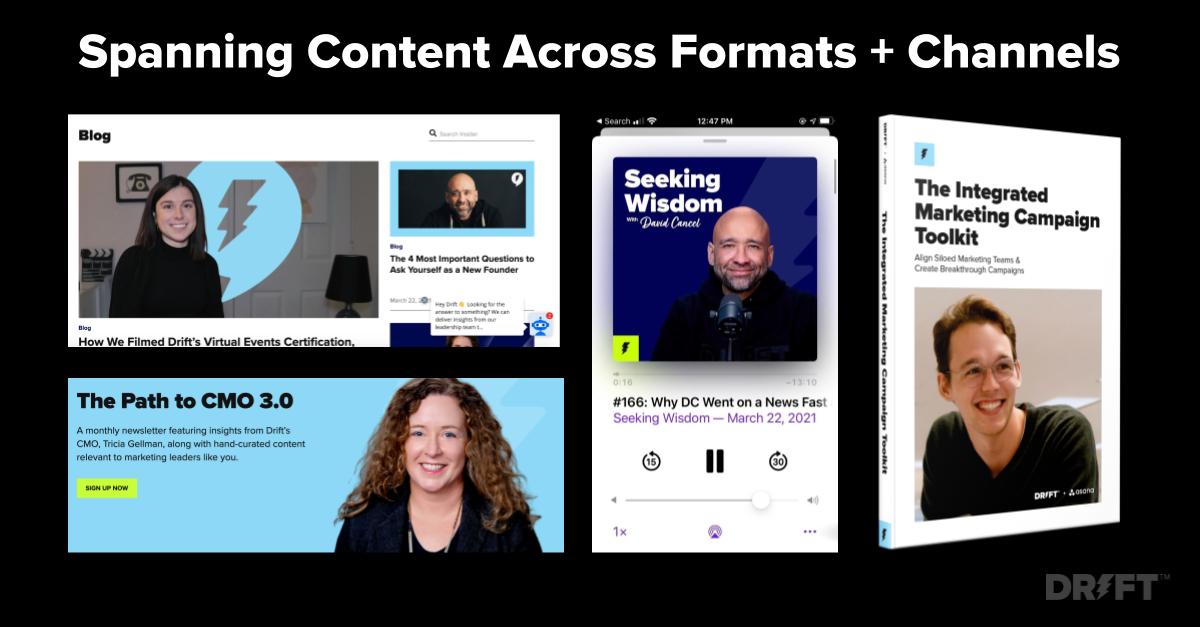
If you have a podcast, can you transcribe that and turn that into a blog? Same with a webinar. (Like I mentioned earlier, this post is one example of repurposing a webinar into a blog post. Listen to the original recording here.)
Could you turn your podcast into a byline or could you turn a collection of blog posts or podcasts into ebooks?
Here’s what that looks like at Drift. We took one of our ebooks on integrated marketing campaigns and turned it into a blog post, but the possibilities are endless:

How do we keep track of everything? We have a very robust content calendar filtered by asset type. So whether that’s blog posts, podcasts, ebooks, or something else, everything has an assigned owner, a due date, and any sub-tasks in terms of SEO optimization or creative assets.
Once you’ve done that, you can focus on how to drive demand.
4 Different Ways to Amplify Your Content Strategy & Drive Demand
You’ve spent all that time and effort developing content in all these different formats.
But if you don’t pay attention to the promotion strategy, no one will ever see your work. You need to amplify your content to be heard.
Your content doesn’t have to stay trapped at the top of the funnel for inspiration or thought leadership. Content marketing can drive real demand for your products and services, helping you do everything from get more leads to convert new prospects and upsell/cross-sell existing customers.
Yes, content can do all that.
Middle of the funnel (MOFU) content looks like:
- Newsletters
- ebooks
- Proprietary research
- Infographics
- Content bundles
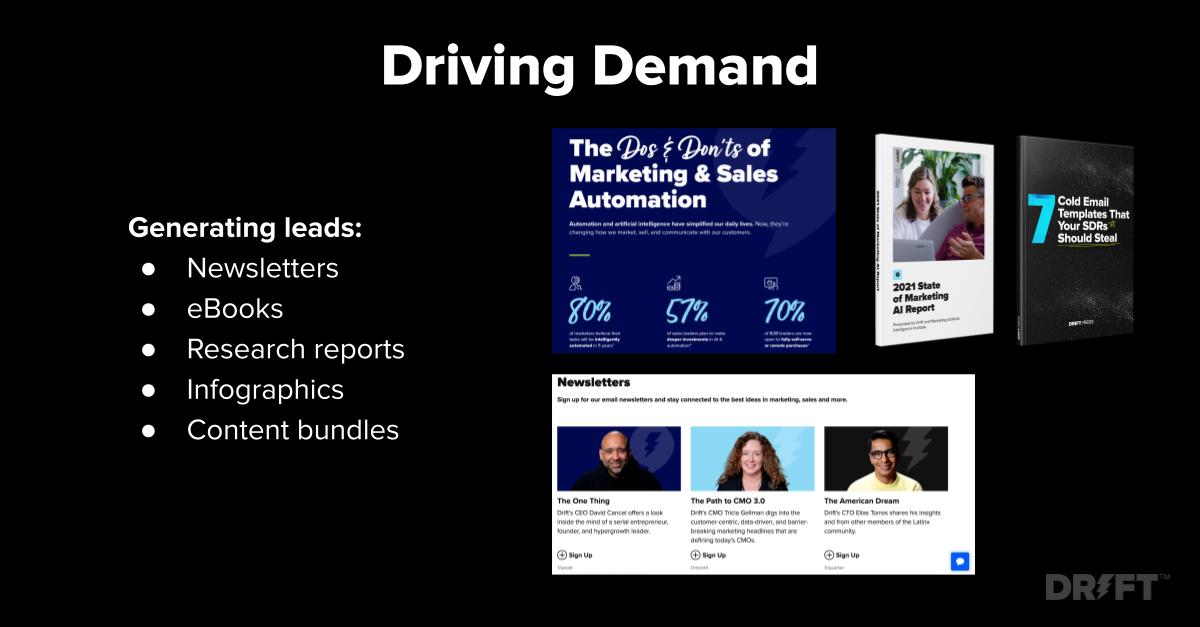
And pair that with bottom of the funnel (BOFU) content, which looks like:
- Customer stories
- Case studies
- Certifications
- Training
- Onboarding
- More tactical feature- and product-related blog posts
Here are four ways to amplify all those different kinds of content to maximize conversion:
1. Landing Pages = Foundation for Promotion
The biggest misconception I see with new content is jumping right to email, ads, or social media.
Step one when it comes to amplifying content is actually your landing page.
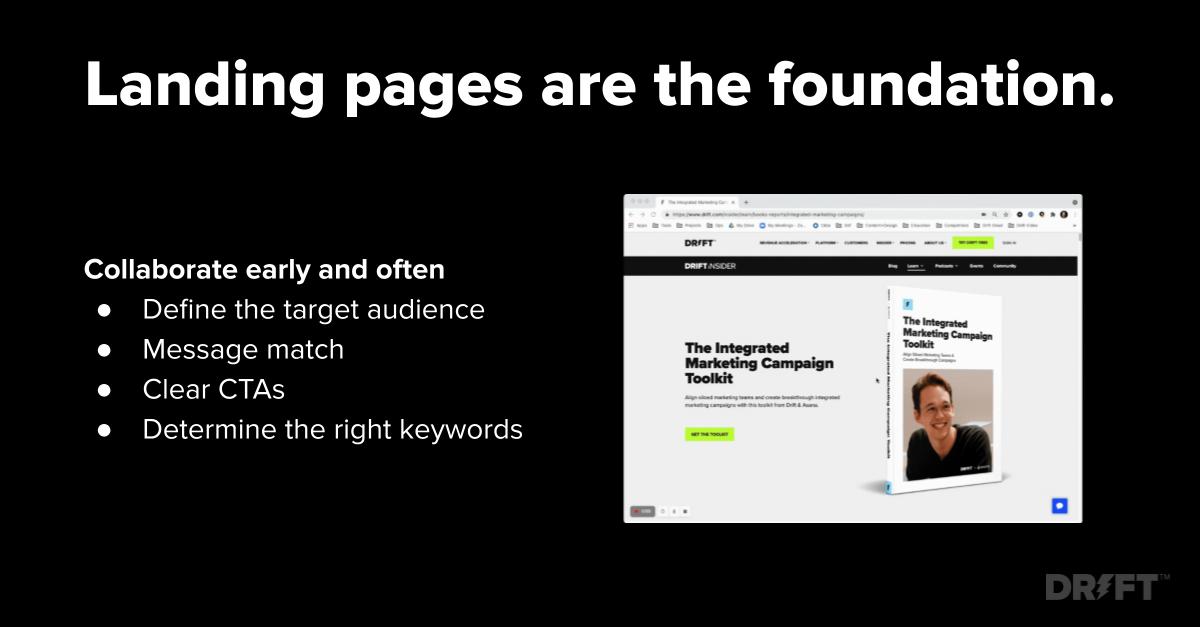
Your landing page is the foundation of your content promotion strategy.
But landing pages aren’t a catch-all. Get super clear on the target audience for your piece of content – and then the landing page flows from there. That’s going to be the foundation of what’s called message matching. It’s where you match a landing page’s copy, images, and offers across every type of promotion.
Message matching creates an echo chamber of connected experiences for readers that gives a sense of cohesion and increases demand. There are no surprises – what you see in the promotion is what you get on the landing page. That’s going to enable us to drive demand for this content and increase actual conversion rates throughout its entire life cycle, not just on launch day.
Once you’ve got the right messaging hook for the landing page itself, optimize the page for organic search, keeping a 1-3% keyword density throughout. That means inserting relevant keywords into:
- URL and title tag
- H Tags
- Body text and meta descriptions
- Alt text
- Link building
Your optimized landing page is what’s going to really drive the conversion rate for your offer. But that doesn’t mean you need to gate all of it.
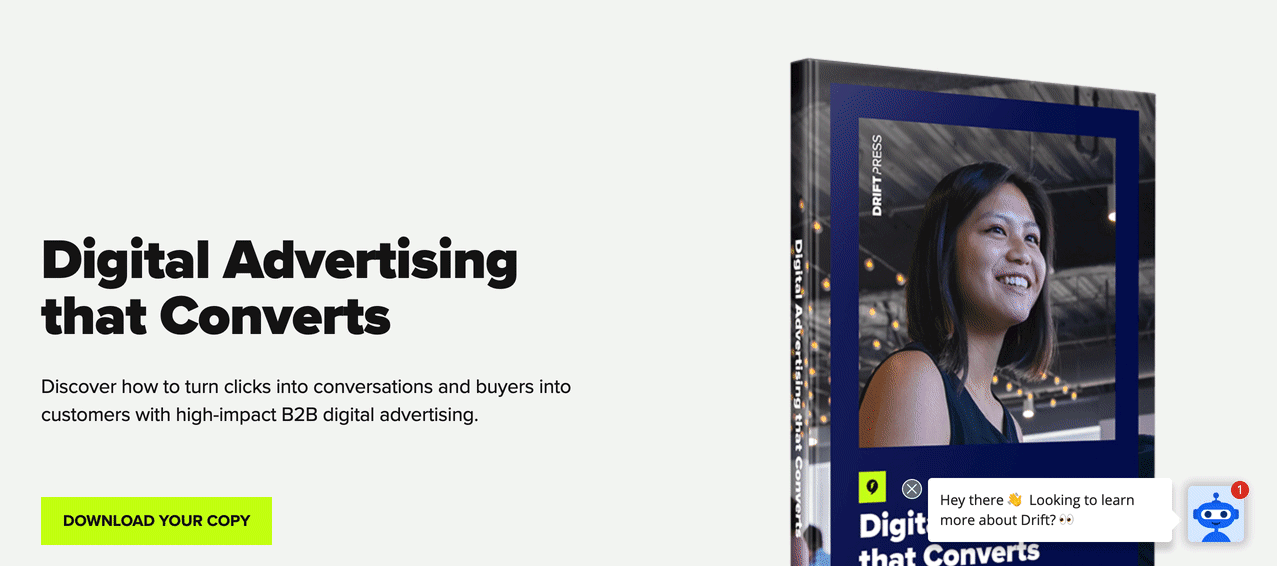
There’s an obvious SEO implication for providing more of your content on the landing page, whether it’s the first few chapters of your eBook or a transcription of your webinar. But the real reason why we do this is that we want to make things as smooth and as frictionless as possible for our readers.
That’s who we’re writing for.
2. Conversational Marketing Generates Leads
But how will you capture leads, you ask? Enter: Conversational Marketing.
We use chatbots so that as someone is reading through a page, they don’t hit a wall with a form or pop-up, but can instead digest the content, understand it, and engage with it naturally.
When a reader comes to your site, they can simply say, “Yes. I want a copy of this ebook emailed to my inbox directly,” or “Yes, I want to see more content on this topic.”
It’s this real frictionless, customer-centric approach to position your content on your landing page and enable people to interact with it. To give you some ideas and inspiration for your website, this is just one example of how we incorporate Conversational Marketing onto an actual ebook page:
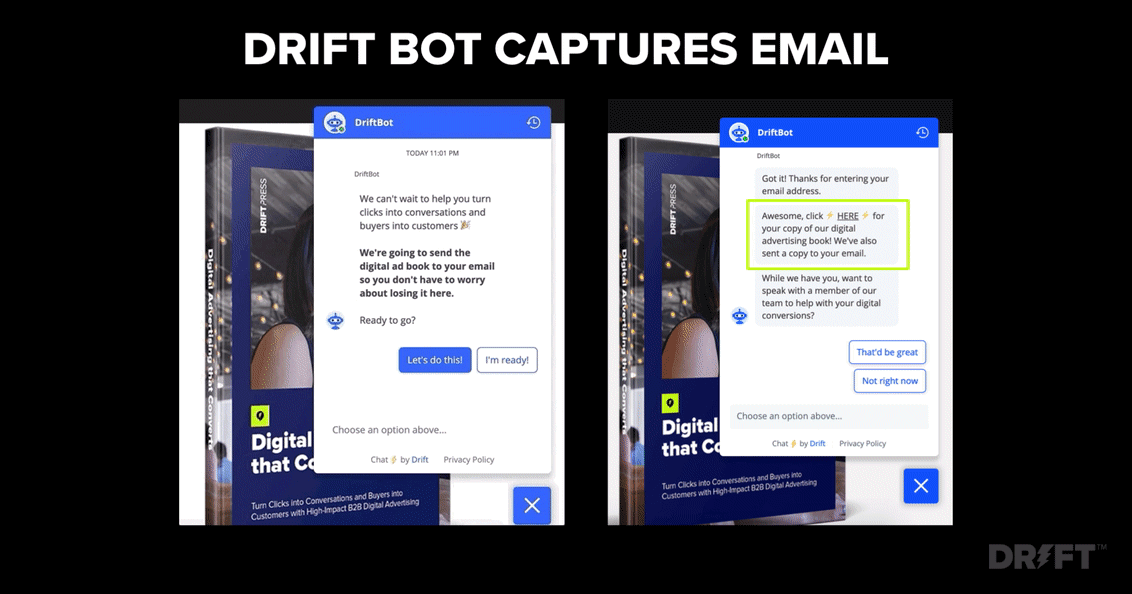
You want to engage readers in a much more human and approachable way. With this conversational approach to marketing, you’re not sacrificing anything that you might’ve gotten from the form either.
You’re still able to capture someone’s email address, ask them questions about their job title, their role, and what they do. You’re just positioning it in a much more authentic way and enabling the buyer to do this on their terms.
You’re providing much more value to the buyer…and you still achieve your business goals.
Case in point: we almost doubled the conversion rates on some of our content.
Sign. Me. Up. 🙋♀️
3. Advertising Brings in New Prospects
The most obvious place to start with promotion is with digital advertising. You can do that across a wide variety of channels, from paid social ads to paid search and display ads.
There are so many options. Where to begin?
No matter which path you’re going to go down, you want to start in the same place as we did with your landing page: Your audience.
Who is the target audience for the offer? What is the offer (a book, webinar, or white paper?) Why is it relevant to your audience?
That’s the message matching component. Build a continuous experience from the ad all the way to the landing page so that everything is as frictionless as possible and is oriented around the pain points of that target audience (and how your piece of content helps them solve those pain points).
Your ad is the hook to get someone interested enough in your offer – your landing page and Conversational Marketing do the rest.
And remember, it’s not one ad and done. There’s a reason there are so many channels available to you. Think about every piece of the funnel and how you can use advertising to drive buyers and prospects to your content:
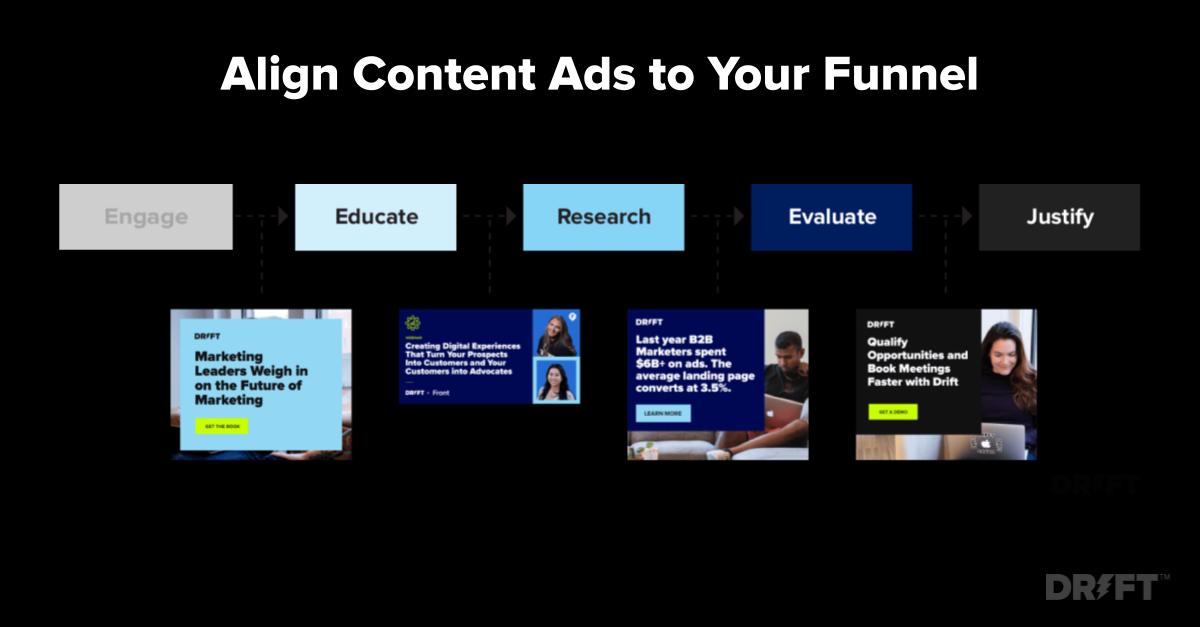
4. Email Nurtures Prospects to a Purchase
Another channel everyone immediately jumps to is email. And that’s for good reason: it’s a great way to get right in front of someone in your target audience with a 1:1 interaction.
When you think about email, you want to apply some of the same Conversational Marketing principles to best amplify your content strategy.
First, use email to start a more authentic, human conversation with someone.
That way it’s much more engaging. A subscriber is much more likely to pay attention to a personalized email that speaks directly to their needs instead of an impersonal, branded newsletter or other offer.
Take the extra step to translate why your offer is going to be interesting or valuable to this specific person.
The first step: thinking about your sender – both the “from” name and the email address itself.
Yes, it’s something you can (and should) edit. Who do you want this piece of content to come from? You don’t want to send from a no-reply inbox if you can help it. Ideally, it should come from a person within your organization – maybe it’s the organizer of the webinar or the author of the ebook.
That sets the tone that it’s a real person behind the screen and encourages more replies.
Then, write like you talk.
The email promoting a piece of content should sound like the kind of email you send to a colleague saying, “You have to read/listen/watch this! It just blew my mind!”
Here’s an example of what that looks like:
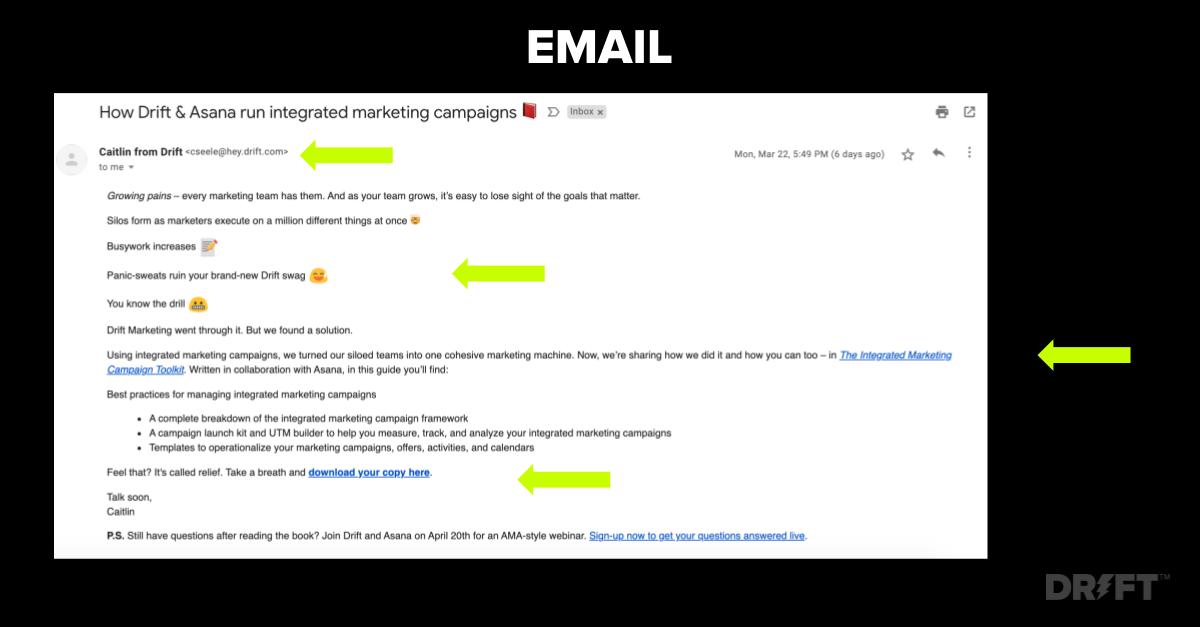
You’ll notice I’m not using fancy formatted HTML templates. When I write promotional emails, I do an old-fashioned test: I read it out loud. Does it sound like something I’d actually say? (Because let’s be real, no one actually says “limited time offer” in real life. At least, not seriously.)
I’ve also kept the messaging very scannable, and no more than a few paragraphs of text. Use line breaks, spacing, and bullets to your advantage. Use things like emojis, images, or even embedded videos to draw people’s attention as they read through the email.
Awareness + Demand Builds a Successful Content Marketing Strategy
Now comes the hard part: Tying it all back to the bottom line.
You want to look at four main metrics:
- Interested people (aka qualified leads)
- Direct and organic traffic
- Keyword rankings
- Content attribution, using a tool like Bizible
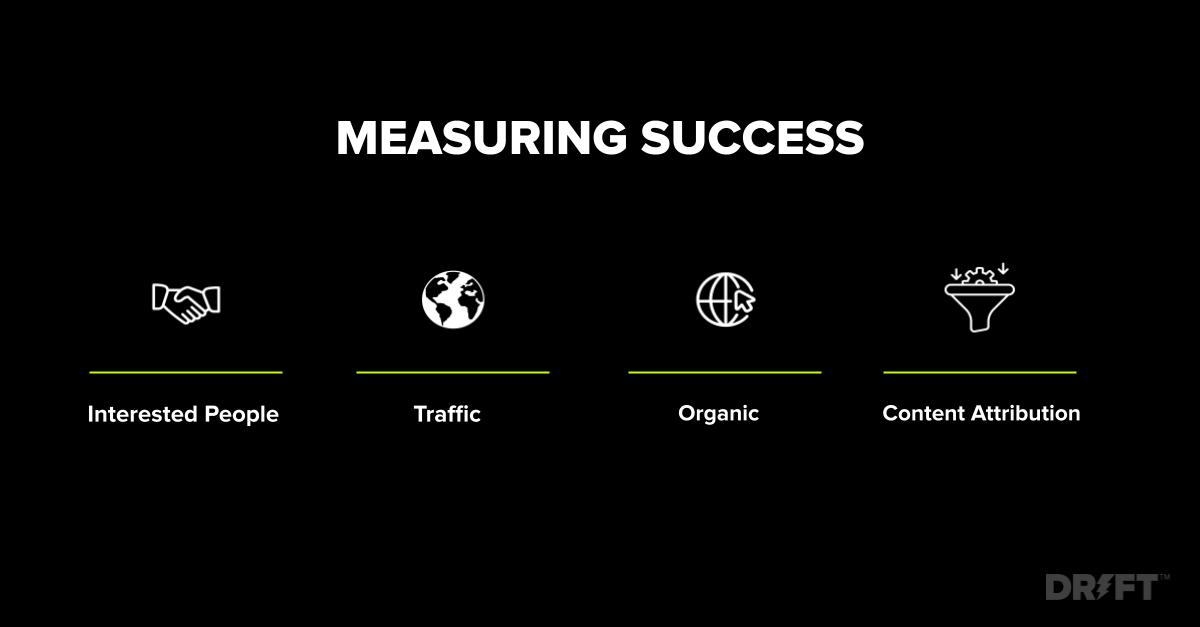
That way we can see how our content efforts map to our performance.
The goal of any metric you’re measuring is to do something about it. Let’s say that in your content attribution phase, you can see that you’re generating a lot of leads, a lot of conversions, and a lot of engagement through a certain piece of content. That means you need to leverage it more often…and build more content just like it.
That way you can get smarter with your offers over time, picking up on key themes and trends for generating new content and refreshing older content.
Content is a long game. You need to be persistent and consistent. At Drift, we publish every single day:
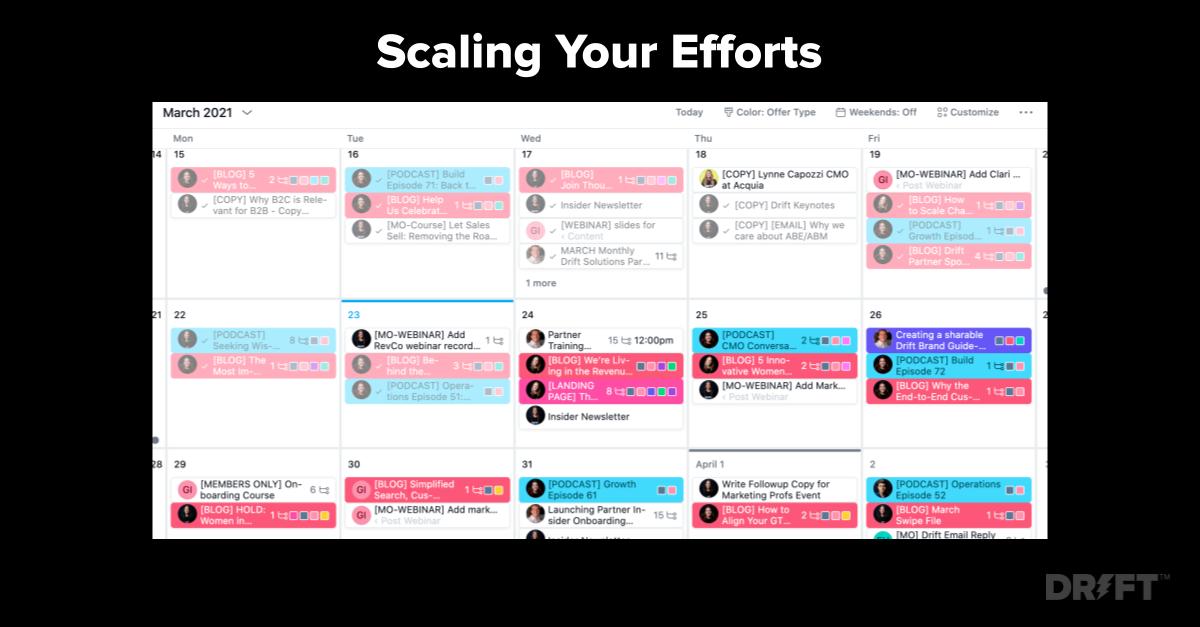
Our calendar looks like a LOT. It takes a network of people from around the company on our content and digital teams to make this channel work.
It’s important not to get discouraged. Sometimes it can take weeks or months to see a lift in terms of SEO. If you’re just getting started with your content strategy, it won’t happen overnight.
But if you keep a relentless focus on your audience – what pain points you can solve, what topics resonate with them, where you’re seeing the most engagement and conversation – you’ll start to see that impact on your bottom line.





